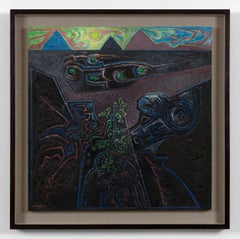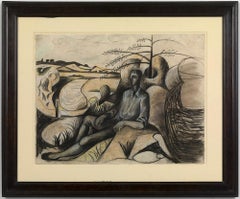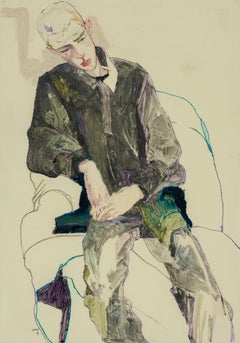John Craxton Art
3
2
3
2
1
Overall Height
to
Overall Width
to
3
3
2
1
1
1
1
3
2
1
3
6,847
3,168
2,517
1,217
2
1
1
1
1
Artist: John Craxton
Volcanic Landscape - 20th Century, Tempera on board by John Craxton
By John Craxton
Located in London, GB
Tempera and volcanic ash on board.
Signed lower left; also signed, titled and dated 1973 verso.
Category
1970s Modern John Craxton Art
Materials
Tempera, Board
Dancer in a Landscape - 20th Century, Work on paper by John Craxton
By John Craxton
Located in London, GB
Pencil, charcoal and conté crayon and gouache on paper
Provenance:
Christopher Hull Gallery
Private collection, UK 1992
Category
1940s Modern John Craxton Art
Materials
Paper, Charcoal, Crayon, Gouache, Pencil
Landscape (Spetses, Greece) - 20th Century, Mixed media on paper by John Craxton
By John Craxton
Located in London, GB
Mixed technique on paper. Dated lower left in ink: "10.10.46" and signed.
Category
1940s Modern John Craxton Art
Materials
Mixed Media
Related Items
Atlanta
Located in ATLANTA, GA
Few artists in Venezuela have the fortune of the affection and the overwhelming admiration of the city that saw them born, like the one expressed by Barquisimeto and the Barquisimeta...
Category
20th Century Modern John Craxton Art
Materials
Mixed Media
Lee Hurst (3/4 Figure, Hands Together), Mixed media on Pergamenata parchment
By Howard Tangye
Located in London, GB
Howard Tangye (b.1948, Australia) has been an influential force in fashion for decades. Lecturing at London’s Central Saint Martins for 35 years, including 16 years as head of BA Wom...
Category
2010s Contemporary John Craxton Art
Materials
Paint, Paper, Parchment Paper, Charcoal, Crayon, Oil Crayon, Oil Pastel,...
Landscape - Tempera - 1950
Located in Roma, IT
"Landscape" is an original painting in tempera and collage on cardboard, realized by Anonymous Artist of 20th Century.
In good conditions.
The artwork represents a summer landscape...
Category
1950s Modern John Craxton Art
Materials
Cardboard, Tempera
Freya (Seated Backwards), Mixed media on grey board
By Howard Tangye
Located in London, GB
Howard Tangye (b.1948, Australia) has been an influential force in fashion for decades. Lecturing at London’s Central Saint Martins for 35 years, including 16 years as head of BA Wom...
Category
2010s Contemporary John Craxton Art
Materials
Other Medium, Archival Paper, Handmade Paper, Pen, Felt Pen, Permanent M...
The Carved Door, Semi-Abstract Tempera Landscape Painting with Flora and Fauna
By Archie Musick
Located in Denver, CO
Tempera on board painting titled 'The Carved Door' by Archie Musick, signed by the artist in the lower right corner. Depicts a semi-abstract landscape with flora and fauna. Presented...
Category
Mid-20th Century American Modern John Craxton Art
Materials
Board, Tempera
H 22 in W 11 in D 0.75 in
Rabbit Hunters
By Roger Medearis
Located in Los Angeles, CA
Rabbit Hunters, egg tempera on Masonite, 12 x 9 inches, 1947, signed and dated lower left, signed, titled and dated verso “Rabbit Hunters Egg Tempera Roger Medearis 1947,” exhibited ...
Category
1940s American Modern John Craxton Art
Materials
Tempera, Board
Pikes Peak, 1940s Colorado Mountain Landscape in Autumn, Tempera Painting
By Charles Ragland Bunnell
Located in Denver, CO
Original vintage 1941 Colorado landscape painting with autumn leaves and Pikes Peak blanketed in snow by Charles Bunnell (1897-1968). Inscribed verso, "To Laura, November 22, 1941", egg tempera on board. Signed by the artist in the lower left corner and titled verso. Presented in a custom frame, outer dimensions measure 15 ½ x 19 ¼ x 1 ¼ inches. Image size is 7 ¾ x 11 inches
About the Artist:
Artist and teacher, Charles ("Charlie") Bunnell worked in a variety of styles throughout his career because as an artist he believed, "I’ve got to paint a thousand different ways. I don’t paint any one way." At different times he did representational landscapes while concurrently involved with semi- or completely abstract imagery. He was one of a relatively small number of artists in Colorado successfully incorporating into their work the new trends emanating from New York and Europe after World War II. During his lifetime he generally did not attract a great deal of critical attention from museums, critics and academia. However, he personally experienced a highpoint in his career when Katherine Kuh, curator at the Art Institute of Chicago, personally chose one of his paintings - Why? - for its large exhibition of several hundred examples of abstract and surrealist art held in 1947-48, subsequently including it among the fifty pieces selected for a traveling show to ten other American museums.
An only child, Bunnell developed his love of art at a young age through frequent drawing and political cartooning. In high school he was interested in baseball and golf and also was the tennis champion for Westport High School in Kansas City. Following graduation, his father moved the family to Denver, Colorado, in 1916 for a better-paying bookkeeping job, before relocating the following year to Colorado Springs to work for local businessman, Edmond C. van Diest, President of the Western Public Service Company and the Colorado Concrete Company. Bunnell would spend almost all of his adult life in Colorado Springs.
In 1918 he enlisted in the United States Army, serving in the 62nd Infantry Regiment through the end of World War I. Returning home with a 10% disability, he joined the Zebulon Pike Post No. 1 of the Disabled American Veterans Association and in 1921 used the benefits from his disability to attend a class in commercial art design conducted under a government program in Colorado Springs. The following year he transferred to the Broadmoor Art Academy (founded in 1919) where he studied with William Potter and in 1923 with Birger Sandzén. Sandzén’s influence is reflected in Bunnell’s untitled Colorado landscape (1925) with a bright blue-rose palette.
For several years thereafter Bunnell worked independently until returning to the Broadmoor Art Academy to study in 1927-28 with Ernest Lawson, who previously taught at the Kansas City Art Institute where Bunnell himself later taught in the summers of 1929-1930 and in 1940-41. Lawson, a landscapist and colorist, was known for his early twentieth-century connection with "The Eight" in New York, a group of forward-looking painters including Robert Henri and John Sloan whose subject matter combined a modernist style with urban-based realism. Bunnell, who won first-place awards in Lawson’s landscapes classes at the Academy, was promoted to his assistant instructor for the figure classes in the 1928-29 winter term. Lawson, who painted in what New York critic James Huneker termed a "crushed jewel" technique, enjoyed additional recognition as a member of the Committee on Foreign Exhibits that helped organize the landmark New York Armory Exhibition in 1913 in which Lawson showed and which introduced European avant-garde art to the American public.
As noted in his 1964 interview for the Archives of American Art in Washington, DC, Bunnell learned the most about his teacher’s use of color by talking with him about it over Scotch as his assistant instructor. "Believe me," Bunnell later said, "[Ernie] knew color, one of the few Americans that did." His association with Lawson resulted in local scenes of Pikes Peak, Eleven Mile Canyon, the Gold Cycle Mine near Colorado City and other similar sites, employing built up pigments that allowed the surfaces of his canvases to shimmer with color and light. (Eleven Mile Canyon was shown in the annual juried show at the Carnegie Institute in Pittsburgh in 1928, an early recognition of his talent outside of Colorado.) At the same time, he animated his scenes of Colorado Springs locales by defining the image shapes with color and line as demonstrated in Contrasts (1929). Included in the Midwestern Artists’ Exhibition in Kansas City in 1929, it earned him the gold medal of the Kansas City Art Institute, auguring his career as a professional artist.
In the 1930s Bunnell used the oil, watercolor and lithography media to create a mini-genre of Colorado’s old mining towns and mills, subject matter spurned by many local artists at the time in favor of grand mountain scenery. In contrast to his earlier images, these newer ones - both daytime and nocturnal -- such as Blue Bird Mine essentially are form studies. The conical, square and rectangular shapes of the buildings and other structures are placed in the stark, undulating terrain of the mountains and valleys devoid of any vegetation or human presence. In the mid-1930s he also used the same approach in his monochromatic lithographs titled Evolution, Late Evening, K.C. (Kansas City) and The Mill, continuing it into the next decade with his oil painting, Pikes Peak (1942).
During the early 1930s he studied for a time with Boardman Robinson, director of the Broadmoor Art Academy and its successor institution, the Colorado Springs Fine Arts Center from 1930 to 1947. In 1934 Robinson gave him the mural commission under the Public Works of Art Project (PWAP) for West Junior High School in Colorado Springs, his first involvement in one of several New Deal art...
Category
1930s American Impressionist John Craxton Art
Materials
Egg Tempera, Board
H 15.5 in W 19.25 in D 1.25 in
Mexico
By Catherine Koenig
Located in Buffalo, NY
An original realist egg tempera painting by American artist Catherine Koenig created during her travels to Mexico. This work will be featured in the gallery's upcoming exhibition "Dr...
Category
21st Century and Contemporary Realist John Craxton Art
Materials
Board, Egg Tempera
Untitled Acrylic Architectural Landscape Painting
By Anthony V. Martin
Located in Houston, TX
Architectural landscape painting by Anthony V. Martin of a white house with a lovely green velvet mat and a gold frame.
Artist Biography: Anthony V. Martin grew up in east Texas. H...
Category
1960s Modern John Craxton Art
Materials
Egg Tempera
H 15 in W 16.5 in D 1.5 in
Spring Storm, Modernist Southwestern New Mexico Landscape Casein Painting
By Doel Reed
Located in Denver, CO
Spring Storm, original vintage painting by New Mexico & Oklahoma modernist, Doel Reed (1894-1985). Evening scene with hint of a moon, clouds and rain over a rocky western landscape with low mountains/buttes, dated, June 1980 and signed by the artist lower right. Presented in a custom frame, outer dimensions measure 24 ½ x 37 ½ x 1 ¼ inches. Image size is 14 ¾ x 27 ¾ inches.
Provenance: Private Collection, Denver, Colorado
Expedited and international shipping is available - please contact us for a quote.
About the Artist:
Early in his artistic career, Doel Reed knew he wanted to be a printmaker. Influenced by Goya's aquatints, he extended himself beyond his formal art training to learn this technique, and he established himself as one of its masters. For decades, he devoted himself to the art program at the University of Oklahoma, taking it from a faculty of one to a major mid-Western department. Upon retirement, Reed focused totally on his work, moving with his family to Taos, New Mexico, where they had previously summered. Marked by strong tonal contrasts, his landscapes of this region are deeply emotional renderings with a sense of mystery -- modernist forms combined with romantic moodiness.
Born and raised in Indiana, Reed originally studied architecture, which he credits with a lifelong attention to "how something is constructed." His mature style can be characterized as architectonic in his concern with assembling volumes and planes. Even the intense northern New Mexico light becomes the means to articulate three-dimensional patterns into cubistic interplay. When painting, Reed used thick strokes of oil and casein as another structural element.
Transferring to fine art, his studies at the Cincinnati Art Academy were then interrupted by military service in World War I. Suffering a gas attack in the trenches of France, Reed spent months in a hospital temporarily blinded. The effects of the gas also damaged his lungs, which later prompted him to live in the dry climates of Oklahoma and New Mexico.
After the war, he returned to his studies, but it was discovery of Goya's aquatints rather than his art classes that inspired. Considered the master, Goya drew on the tonal range available with this medium to create powerfully haunting imagery. Perhaps Reed responded personally to the eloquent series "The Disasters of War." Now his course was set, and he built his own etching press, which he continued to use for the rest of his life.
In 1924, he accepted a teaching position at Oklahoma State University, where he remained for thirty-five years. Emphasizing drawing, Reed encouraged students to go to nature and translate the scene through their own sensibilities. Beginning as the sole art professor, he developed the program when it became an independent department in 1930. Through his stewardship, the university gained a reputation as one of the best for printmaking in the country. During the forties, Reed also prepared a series of lectures and demonstrations on aquatint for the Association of American Colleges. His most public offering in art education is the book "Doel Reed Makes An Aquatint" (1965).
Sabbaticals allowed him to visit Paris in 1926 and 1930-31. Summer travel took him to Nova Scotia and Mexico, but gas rationing during World War II necessitated a closer destination. Thus the Reed connection with Taos was established. Finally in 1959, he, his wife, and daughter moved there to Talpa Ridge, the same outlying area in which artists like Andrew Dasburg, Howard Cook, and Barbara Latham resided. Settling into a complex of three adobe buildings, Reed was welcomed by these artists, who referred to their community as Neurosis Ridge. Rena Rosenquist of Mission Gallery remembers that Reed was "the most affable man" who liked cold martinis.
For Reed, the surrounding Sangre de Cristo Mountains offered "end of abstract pattern." His inventive mind came up with techniques to transform a natural scene into a richly dimensional object. He fashioned a rosin box and concocted his own formula of etching ground to achieve a velvety texture with his prints. Described as "not for the faint-hearted,”" casein became a medium with which built up paint surfaces that almost seem sculpted. Both the prints and drawings are characterized by a tension between the two-dimensional surface pattern and the articulated space it conveys.
In addition to landscapes, Reed produced a number of works of voluptuous women with the figures echoing landscape elements. As a boy, his first art experience was a grade-school field trip to the John Herron Art Museum (now the Indianapolis Art Museum), where he expressed his admiration for a painting of a nude mermaid -- an image that made a lasting impression.
Reed was proudest of his recognition by the National Academy of Design (now just the National Academy). In 1942, he was named associate member; in 1952, he was named full academician. ©David Cook Galleries, LLC
Exhibited: Society of Independent Artists, 1927 & 1929; Society of American Etchers, 1930-1946; Kansas City Art Institute, 1932; “100 Etchings of Year,” 1932-44; Art Institute of Chicago, 1934, 1937, 1939; National Academy of Design, 1934-46, 1965 (Samuel Morse Medal); Tulsa Art Association, 1935 (prize); Paris Salon, 1937; Rome, Italy, 1937; Sweden, 1938; Chicago Society of Etchers, 1938 (prize); Corcoran Gallery of Art, Washington, D.C., 1940; Philadelphia Print Club, 1940 (prize); Venice, Italy, 1940; Carnegie Institute, 1941; Currier Gallery of Art, Manchester, NH,1942, (prize); Metropolitan Museum of Art, 1942; Whitney Museum of American Art, 1942; Northwest
Printmakers, 1942 (prize), 1944 (prize); Herron Art Institute, 1943; Library of Congress, 1944-46; Pennsylvania Academy of the Fine Arts, 1944-45; Philbrook Art Club, 1944 (prize); Laguna Beach Art Association, 1944 (prize); Southern States Art League, 1944 (prize); “50 American Prints,” 1944; Oakland Art Gallery, 1945 (prize); Audubon Artists, 1945, 1951 (Gold Medal of Honor), 1954 (John Taylor Arms Memorial Medal); Albany Institute of History and Art, 1945; Pasadena Art Institute, 1946; London; Allied Art Association; National Society of Painters Casein; Mission Gallery, Taos, NM, and Blair Galleries, Ltd. Santa Fe, NM.
Works Held: Carnegie Institute; Honolulu Academy of Art; Grinnell College; Library of Congress; Metropolitan Museum of Art; Museum of Fine Art, Houston; New York Public Library; Oklahoma Art Club; Pennsylvania Academy of Fine Art; Philadelphia Museum of Art; Philbrook Art Club; Seattle Art Museum; Southern Methodist University; University of Montana; University of Tulsa; Bibliotéque Nationale, Paris; Victoria and Albert Museum, London.
Further Reading: Harmsen's Western Americana: A Collection of One-Hundred Western Paintings with Biographical Profiles of the Artists, Dorothy Harmsen, Northland Press, Flagstaff, Arizona, 1971.; The Illustrated Biographical Encyclopedia of Artists of the American West, Peggy and Harold Samuels, Doubleday & Company, Inc., Garden City, New York, 1976.; Taos Artists...
Category
1980s American Modern John Craxton Art
Materials
Casein, Archival Paper
H 24.5 in W 37.5 in D 1.25 in
Mosque in Constantinople - Drawing - Mid-20th Century
By Gustavo Francalancia
Located in Roma, IT
Mosque in Constantinople is an original artwork realized in the mid-20th century, and attributed to Gustavo Francalancia.
Original mixed colored tempera and watercolor on plywood.
...
Category
Mid-20th Century Modern John Craxton Art
Materials
Tempera, Watercolor
H 27.56 in W 23.63 in D 0.04 in
Jake W. (Before Paris II), Mixed media on Fabriano paper
By Howard Tangye
Located in London, GB
Howard Tangye (b.1948, Australia) has been an influential force in fashion for decades. Lecturing at London’s Central Saint Martins for 35 years, includi...
Category
2010s Contemporary John Craxton Art
Materials
Felt Pen, Pencil, Carbon Pencil, Color Pencil, Graphite, Gesso, Pigment,...
John Craxton art for sale on 1stDibs.
Find a wide variety of authentic John Craxton art available for sale on 1stDibs. You can also browse by medium to find art by John Craxton in paint, board, charcoal and more. Much of the original work by this artist or collective was created during the 20th century and is mostly associated with the modern style. Not every interior allows for large John Craxton art, so small editions measuring 19 inches across are available. Customers who are interested in this artist might also find the work of Modern British, Laurence Jones, and Mary Fedden.
Artists Similar to John Craxton
Robert Sargent Austin, R.A., P.R.E., P.R.W.S.




